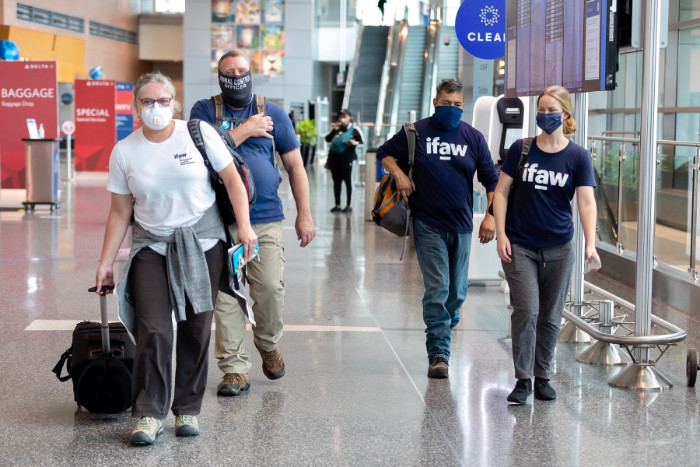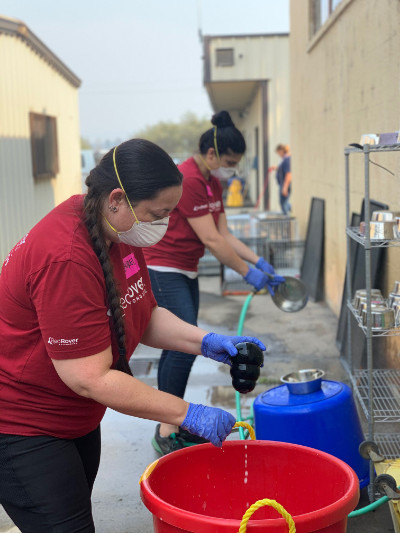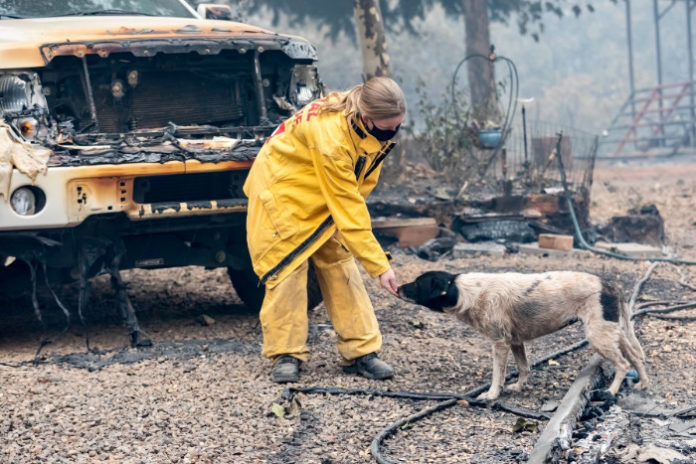Last week, I mentioned that there were a number of people coming to help locally with the emergency animal shelters established here in Butte County, California, where the North Complex West Zone fire, formerly known as the Bear Fire, has killed 15 people, burned at least 750 homes, and displaced thousands.
The fire was originally started by lightning storms on August 18. Locally, it was controlled and extinguished, but in a neighboring county, it burned in remote, mountainous areas until September 8, when it re-entered our county, driven by a ferocious windstorm. The wind pushed the fire more than 30 miles in the direction of the town where I live, Oroville, California, burning through the small town of Berry Creek and other even smaller remote communities. Within just a couple of days, the existing facility that can shelter small animals in emergencies such as this was holding a couple hundred dogs and cats.
I know this is just one fire among many burning across the western United States right now, so I’m even more humbled by the fact that volunteers have arrived from far and near to help the displaced and evacuated animals in my community.
Hundreds of dogs, cats, rabbits, birds, and smaller pets, and dozens of horses, llamas, pigs, sheep, goats, and chickens and other barn yard birds are being sheltered in three different locations in my town. Caring for them are a few animal control officers and dozens of volunteers. Many of the animals are considered “stray,” having been brought to the shelters by first responders on the fire lines, or by citizens who found them running loose as they themselves evacuated from the fires. Others were brought to the shelters by their owners, who have either lost their homes or are being kept from their homes by road closures in the area where the fire is either still actively being fought, or where the damage from the fire and firefight have rendered the area unsafe (downed power lines, trees fallen or falling across the roads, roads damaged by bulldozers, etc.).
As with the infamous Camp Fire of 2018, it’s expected that it will take weeks, if not months, for most of the displaced animals to be identified and/or picked up by their owners. Some may be surrendered to the county animal control, if their owners have no place to keep them.
Once again, our local animal rescue group NVADG leads the rescue efforts
Much of the heavy lifting is performed by volunteers belonging to a local group, the North Valley Animal Disaster Group (NVADG, pronounced as “NAV-Dag). When animals are affected by a local fire or other disaster (including floods, animal trailer rollovers, horses who have fallen off cliffs, etc.), county animal control officers contact and activate NVADG. Experienced NVADG volunteers set appropriate actions into motion; in this case, volunteers immediately went to work opening buildings lent to NVADG by the county to use for this purpose, and started setting up crates and an intake process to identify and track each animal brought to the shelter. NVADG volunteers care for the animals, with supervision and oversight provided by county animal control officers.
It’s a rough fact that the process of keeping these animals safe is highly stressful for the sheltered small animals, no matter how good their keepers’ intentions for them are. Cats are in cages with small litterboxes; for the most part, dogs are kept in large wire crates. (Especially huge dogs, such as the Anatolian livestock protection dogs that we are sheltering, or large dogs who prove to be particularly hard to keep enclosed in a wire crate, are kept in small pens within the temporary shelter buildings.) They are taken out of the crates and walked about three times a day – which sounds (and is) incredibly minimal, and yet requires an army of volunteers to accomplish.
I’d like to mention a few of the organizations that have sent workers or volunteers to our shelters from out of this area. I’m honored to have worked alongside many of them.
IFAW

First on the scene from out of the area were folks from the International Fund for Animal Welfare (IFAW, pronounced eye-faw). The organization describes itself as a global non-profit helping animals and people thrive together. They work in more than 40 countries across the globe, partnering with other animal welfare groups and even just concerned citizens who are trying to help animals in their communities. IFAW workers were a huge part of the response to the Camp Fire two years ago, and some of the same individuals who came here then returned to help us again.
IFAW workers flew into California on September 14, and immediately began setting up a second temporary shelter in a leased warehouse. Within a day, animal control officers started transferring “stray” animals from NVADG’s overcrowded site to the more spacious temporary facility. Some IFAW workers stayed on the new site, working alongside NVADG volunteers to care for the animals, while others went into the fire zone with search and rescue teams, looking for hurt animals and ones that had been left behind. These folks work 12- and 14-hour days while thus deployed, and are, to a single person, cheerful, hard-working, and driven to improve the care and treatment of animals in any way they can. Their expertise and guidance to local leaders is incredibly valuable.
Sonoma CART
I lived in Sonoma County, California, during my high school years and as a young adult, so I know that the differences between that county and this one could not be more stark. Sonoma County is wine country, home to lush redwood forests, grassy foothills grazed by dairy cows, an unbelievably gorgeous coastline along the Pacific Ocean, and affluent towns that are home to many urban tech workers. About 200 miles to the north and inland, Butte County is much more economically challenged, hotter, and drier. Butte County’s largest city is smaller than most Sonoma County cities; its total population is less than half of Sonoma County’s.
But they have one thing in common: They both experienced horrific destructive fires in the past three years. The 2017 Tubbs Fire burned in Napa, Lake, and Sonoma counties, but its worst devastation occurred in the city of Santa Rosa, where it killed 22 people and burned thousands of homes and businesses. Sonoma County Animal Rescue Team (Sonoma CART) was already in existence at the time of the fire, and its trained volunteers were instrumental in providing assistance to the animals affected by the Tubbs Fire. In the months and years after the Tubbs Fire, many Sonoma County residents joined Sonoma CART and took its training classes – and many have gone on to respond to calls for help during other California disasters. I’ve met eight or more members of Sonoma CART while working with dogs at the NVADG shelter during this fire, each of whom drove hours to get here, spent their own money to stay in local hotels, and labored for days in a row to feed and walk dogs and care for other animals.
At least one volunteer I worked with spent a week here, working 12-hour days. On her last day here, we shared some bonding moments over a blind, elderly yellow Labrador who needed some extra TLC, and she shared photos of her own senior Labrador, who had died not long ago. She also confided in me that she did this work in honor of her mother, who lost pets in a fire some years ago and “has never been the same since.” We both shed tears as she recounted her mother’s pain; with heavy smoke in the air, surrounded by displaced animals, we could only too keenly imagine losing our own beloved dogs.
Thank you, Sonoma CART, for sending such generous, open-hearted people to help us.
Red Rover

This is another national organization who showed up during the 2018 Camp Fire disaster to help run the emergency animal shelters – and who has sent workers once again to provide our weary local animal control officers with some much-needed respite. Red Rover has more than 4,000 volunteers who have taken one or more training courses in emergency response for animals, and they help provide emergency sheltering assistance for animals displaced by natural disasters and rescued from other crises, such as puppy mills and hoarding situations.
Red Rover workers have been on the ground here for the past few days, and, I hear, more are due to arrive this week. The emergency shelters here will likely be operating for at least another month, if not longer, as so many people have no houses to take their pets home to, so the extra help is highly needed and will be appreciated.
After two weeks, many of us local volunteers are exhausted, or have given as much time as we can spare. Thank goodness for fresh boots on the ground! I’ve been working closely with a Red Rover worker who flew in from New York, who has been helping to run the NVADG shelter for the past few days, giving the NVADG volunteer leaders who had been operating the shelter for the past two weeks a chance to sleep and catch up on their regular-life duties. She’s been amazing and cheerful, even in the face of poop-splattered crates and a too-thin list of local volunteers arriving for the 7 am dog walking and crate-cleaning shift. Devon Krusko, thank you!

Find an “animal rescue” class and take it!
If you ever had a hankering to pitch in to help animals in (or near to) a disaster zone, check out the national organizations IFAW and Red Rover. Both offer courses to help people understand how to work in conjunction with professional rescue workers in an “Animal Incident Command System Matrix.” And if fires or floods or other natural disasters commonly affect or displace people and their pets in your local area, look for a local organization such as NVADG or Sonoma CART to train and work with. Helping feels a whole lot better than just watching and worrying from afar.






Great article with so much helpful/useful information. Thank you!
Agree with your posted comment ‘Ann Johnson’ Great Article!
Praying in Jesus name that there will be peace for all. The wildfires are frightful and so very sad. Pray people donate millions to your cause. I will hope to donate soon. Fabulous Article- very informative!
God bless them! Thanks to all the rescuers who are helping these poor creatures. It is very important to help pets in such a difficult time. When I read such news, I am very happy. I would like to take courses from IFAW and Red Rover. I think it would be a very useful experience. Tell me, is there such an organization in Seattle?
Hi Nancy, thank you so much for the shoutout! Just a small correction – Sonoma CART was started after the 2017 fires, in response to the enormous need in our county.
We’re proud to be able to assist our neighbors in Butte County and NVADG, who we have so much respect for.
Nancy Kerns, I am new to your writing (ever sinced introduced to your work via my new inspiration and mentor, MS), and I just can’t put you down (your work that is) – have to keep reading.
Maybe it’s because of the unusual times we are in and so many previously unimaginable calamities, or maybe its because I just lost my beautiful young dobergirl to cancer and I still reach down to pet her head … only to find the shattered pieces of my broke broken heart down there on the floor… or maybe its because I’ve had to give up my practice for the moment to stay home and reluctantly school my teen who is supposed to be at her new boarding school in Monterey but instead her classroom is my dining room table due to Covid-19.
Whatever the reason – I am finding your stories full of dogs we have no choice but to fall in love with – the blind greymuzzled lab at the fire shelter, the foster dog with the amputated leg and your friends beautiful boy who we all cried with as you retold the story of his beautiful send off to the rainbow bridge. But the thing that really tells your story- is the way you so appreciate each and every volunteer who, without fanfare, show up to do the work and then go back to their own busy lives.
Seeing them though your eyes makes us all want to jump up and drive right over there to help! It makes us also grateful for those volunteers so that the scared and heartbroken displaced animals are given the gift of a warm touch and a kind whisper to make the cold metal of the holding crates and the less-than-luxurious tiny litter boxes a little more bearable while they wait for their owners to come bring them home.
Thank you for reminding us of the powerful gift of volunteering. It honors the animals, provides much needed relief to the over-worked shelter staff and it prompts us readers to look around our own hometowns to see where we can help if we aren’t able to get in our cars and drive to the disaster zone.
Keep em’ coming.
-KR, dvm.
Great article alot information..thank you.
Great info was trying to figure out how to help. You have given me a great option